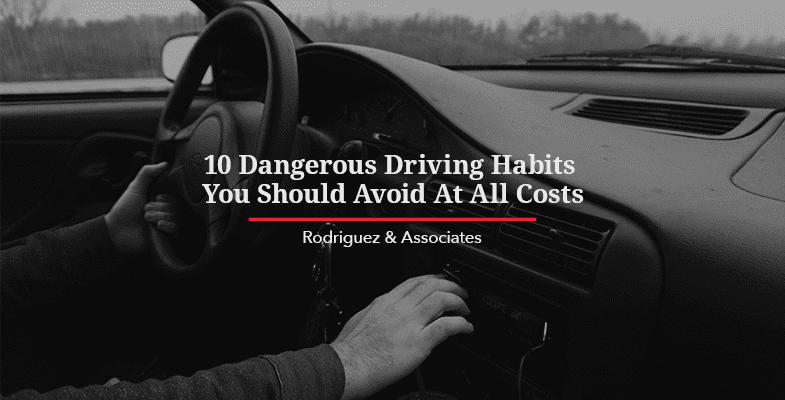All legal drivers on the road must pass a written and road exam before receiving a license and heading out on the open road. This training unfortunately does not stop drivers from engaging in reckless and illegal driving activities. Obligations, emotions, and general carelessness often take the place of common-sense driving safety.
It’s important to keep these factors in mind, as most drivers can check off at least one of these driving behaviors.
Here are our top 10 dangerous driving habits:
- Brake checking. Brake checking occurs when a driver in front of a tailgater hits (not taps) the brakes to startle the rear vehicle into backing off. Tailgating is a frustrating and dangerous driving behavior, but responding with brake checking is just as bad. Instead of responding to road rage with road rage, move over at your earliest convenience to let the tailgater pass or maintain safe speeds and allow the tailgater to pass.
- Tailgating. Drivers should always follow the three second rule to maintain a safe distance from the leading vehicle. Tailgating to make a vehicle move faster or over may inspire an instance of brake checking and/or contribute to a rear-ending accident. Give yourself time to react to sudden traffic stops and unexpected obstacles.
- Speeding. Speeding is dangerous on its own, but it often accompanies every other dangerous driving habit on this list. When drivers combine speed with carelessness, the risk of an accident increases. In practice, a 5-10 mph increased speed will only shave a maximum of a couple of minutes off average daily drives. Such small savings cannot justify the accident risk nor vehicle wear and tear.
- Swerving. A driver that moves suddenly to avoid a hazard may encounter a new one or overcompensate on the way back into a lane. While safely avoiding visible obstacles makes sense, the fast reaction can result in a number of adverse outcomes. Instead, defensive driving professionals urge drivers to stop or slow down instead of swerving.
- Texting/driving distracted. Campaigns across the country warn drivers of the dangers of texting and other distracted driving behaviors. Still, drivers consciously or unconsciously grab for a mobile device as soon as it buzzes or beeps. Any distraction that takes a driver’s eyes off the road for even five seconds dramatically increases the likelihood of an incident.
- Avoiding turn signals. Turn signals are not a courtesy. Under California laws, drivers must signal their intentions within 100 feet of a turn if the turn affects other vehicles. Failing to signal can lead to accidents with other vehicles and bicyclists on the roadways.
- Running a red light. When traffic lights turn yellow, many drivers take the signal as an opportunity to speed up and miss the stop. Unfortunately, this can lead to running a red light and a collision. Drivers can make an effort to stop at every yellow/red light and watch out for other runners to build safe driving habits.
- Impairment. Impairment of any kind slows reaction times, distorts visibility, and increases the likelihood of other reckless driving behaviors. Drivers should never get behind the wheel after drinking, doing drugs, or staying awake for long periods. Call a friend, use a rideshare service, or stay put.
- Lane hopping. Unlike swerving – a reactionary response – lane hopping involves purposeful and quick movement among lanes. Some drivers cut one lane at a time and others cut more. This practice does not give drivers enough time to anticipate other drivers’ movements and can cause serious accidents. Signal and move at an appropriate speed into and out of lanes to contribute to a safe driving environment.
- Driving too fast for road conditions. Rain, debris, hail, and other conditions can decrease visibility and change the way vehicle tires interact with the road. Drivers who do not adjust speeds based on weather conditions can lose control and slide, flip, or spin into other cars or obstacles.
Accidents happen in the blink of an eye and can change a life forever. Safer driving starts with your next driving decision. Focus, follow the rules of the road, and know when to hand over the keys to reduce the likelihood of accidents and injuries.
